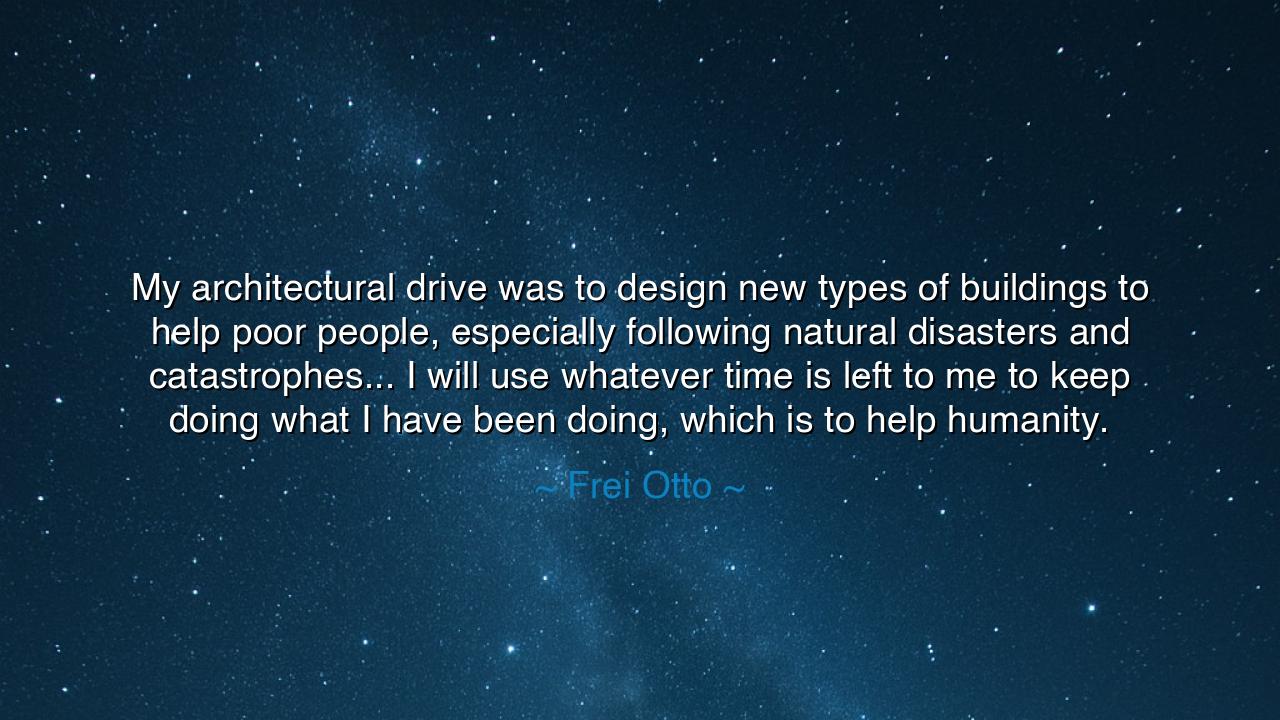
My architectural drive was to design new types of buildings to
My architectural drive was to design new types of buildings to help poor people, especially following natural disasters and catastrophes... I will use whatever time is left to me to keep doing what I have been doing, which is to help humanity.






“My architectural drive was to design new types of buildings to help poor people, especially following natural disasters and catastrophes... I will use whatever time is left to me to keep doing what I have been doing, which is to help humanity.” Thus spoke Frei Otto, the visionary architect whose creations rose not as monuments to wealth or ego, but as sanctuaries for the vulnerable. In this declaration, we hear the voice of a man who saw architecture not as luxury, but as service; not as the art of walls, but as the art of mercy. His words echo through time like a vow — the vow of one who chose to dedicate his craft, his genius, and the twilight of his life to the well-being of humankind.
When Otto speaks of his architectural drive, he is not referring to ambition or fame, but to an inner calling — a sacred compulsion to heal through creation. To him, buildings were not mere structures of steel and stone; they were instruments of life, shaped to protect, uplift, and endure. Where others saw blueprints, he saw refuge. Where others dreamed of skylines, he dreamed of shelters. His vision was born in the ashes of war, in a world shattered by destruction, where millions were displaced and homeless. From those ruins, Otto came to believe that architecture must be humble, light, and compassionate — that it must serve humanity before it serves art.
The origin of this quote lies in the closing years of Frei Otto’s long life, as he reflected upon his journey — a journey that began with hardship and ended with hope. A German architect and engineer, Otto first became known for his ethereal tensile structures, such as the Munich Olympic Stadium and the German Pavilion at Expo 67. Yet behind the beauty of these creations was not vanity, but empathy. He studied nature’s patterns — the web of a spider, the curve of a leaf, the span of a bird’s wing — to learn how to build using the least material, the least waste, the least harm. “More with less” was not his creed of efficiency; it was his creed of compassion. For he understood that the lighter the structure, the more swiftly it could rise in the aftermath of disaster, offering shelter to those who had none.
Frei Otto’s heart was never bound by the glittering cities of the rich, but by the fragile settlements of the poor. After floods, earthquakes, and storms, when chaos swallowed whole communities, Otto turned his mind to emergency housing, to structures that could be built quickly, cheaply, and sustainably. He worked not for applause but for relief — designing tents that could withstand wind, canopies that could breathe, and shelters that could be raised by human hands without machines. To him, architecture was not a monument to the architect, but a gift to the people. And when asked how he wished to spend his final years, he answered simply: “To help humanity.”
This spirit has lived before, in other forms and ages. When the ancient Roman engineer Vitruvius wrote his treatise De Architectura, he declared that architecture must have firmness, utility, and delight — yet Otto added a fourth element: compassion. His work recalls that of Florence Nightingale, who brought light and hygiene into the hospitals of the Crimean War, believing that design itself could heal. Like her, Otto understood that the environment we build shapes the soul — that a well-designed shelter restores not only the body but the dignity of its inhabitant. His architecture was thus not cold geometry, but living mercy — a communion between man, nature, and hope.
Frei Otto’s words also remind us of a greater truth: that time, once given, must be spent in service of others. “Whatever time is left to me,” he said — words of humility, spoken by a man who had already changed the world. Yet to him, the work was never done. The measure of his life was not in awards or buildings, but in acts of care. And in this, he teaches us that mastery is not the pursuit of perfection, but of purpose — that the highest expression of skill is service, and the purest form of design is compassion made visible.
So, let his legacy be a guiding flame for all who build, create, or lead: Use your gifts to lift the fallen. Whatever your craft, bend it toward healing. The engineer, the artist, the teacher, the laborer — all can “up the ante” on humanity through their work. Ask not how much time remains to you, but how much good can yet be done with it. For in the end, the structures we raise will fade, but the kindness we build into them will endure.
And thus, children of creation, remember the path of Frei Otto — the architect who built not only for the eye, but for the soul. Design your lives as he designed his works: lightly, wisely, lovingly. Let your strength be gentleness, your ambition service, your legacy compassion. For to help humanity is to build the only structure that will never fall — a temple made not of steel or stone, but of mercy and eternal light.






AAdministratorAdministrator
Welcome, honored guests. Please leave a comment, we will respond soon